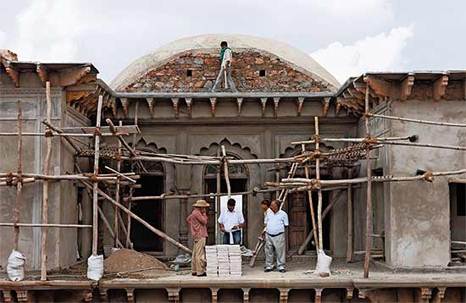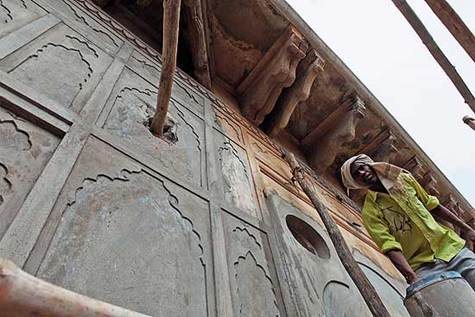How could a crumbled structure with no
completion become an amazing heritage hotel having full of services? Mridula
Gandhi talked about Tijara fortress-palace’s restoration.
February 2011
So far, it had been a smooth trip. A promising
spring dawn’s soft sunshine was spreading my exhausted body in a comfortable
SUV when it brought me back to life by a jolt. We encounter a dirty road, a red
ribbon of marsh. We had been shaken by a seemingly unending path (3km, we were
informed later) until an area of land covered by a beautiful fortress got into
our sight.
The path to this forgotten heritage, from
afar, didn’t seem threatening. However, in the close-up at the foot of the
mound where the fortress rose, the path we left behind suddenly turned out to
be easy. The road ahead was a sloping one full of jagged stones. We had been
struggling with it and 15 minutes later, we reached the peak – a high and windy
point watching over hectares of deserted farmland. Faraway palms were swaying
under immensely blue sky. It was nice ambience for a hotel. And 19th-century
Tijara fort-palace at Alwar belonged to the cleverest hands – Neemrana hotel
group.
I walked with Aman Nath, co-founder of
Neemrana beside Francis Wacziarg, and the interest in restoring historic
memorials gave birth to the nation’s most famous heritage hotels. Though it was
easy to check in a room of their property and live a royal life, it was nearly
impossible to realize how much it cost to turn this crumbled structure into well-equipped
hotels. How could you restore a 15th-century fortress’s original form as well
as its ambience? How much money was spent? How could you manage to work in an
isolated area? Did you import experts or reply on local labors? My question had
been overflowing as the countryside was being revealed below me, and the only
way to find the answer is starting immediately.

Aman
and his workers
“Actually, the beginning was 14 years old”,
Aman said while I was trying to catch up with him through annoying noise made
by bulldozers grinding stones. The 8-hectare landscape, all around, got scarred
by deeply excavated pits and scattered rocks. Workers were everywhere, digging,
hammering, and breaking with all extraordinary kinds of materials. There were enormous
windows and decorated doors, hundreds of stone pillars and archways, giant doors
adorn with stained glass and carvings, a bunch of antiques which were from
“Bhuj and Ahmedabad”. “This is the private-public cooperation and the contract
takes 7 years. And more 7 years is for solving road conflict”, Aman said and
inferred the road we were leaving. After Neemrana won the contract, Aman did
approach the government to find a solution for the dirty road. Instead of that,
the government tried to persuade Neemrana to buy and fix it by the company’s
budget. They clearly refused. However, a bigger problem was that the road
heading uphill was small but full of rocks. Once again, the government denied
giving help. This made Neemrana buy a 1.5-kilometer track along the below land
surrounding to create a border. “When the 60-year contract is over, the
fortress will return to the government while its direct access belongs to us.
How will they manage to enter the fortress?” joked Aman.
The project was first initiated at Tijara
fortress in 1835 by Balwant Singh, prince of Alwar’s separated territory considered
Tijara its capital. It was expected as a tribute to his Muslim mother and
people though that the king didn’t compensate for anything when recruiting professional
builders from Kabul and Delhi. Unfortunately, his early death stopped him from seeing
his work completed. And yet it was still an incomplete structure (there are
basically three separate palaces in a half-fortified wall) until Neemrana took
over.
The work, finally, restarted 2009 with
around $4,500,000. And nothing was easy. “No water, no energy. You didn’t have
pipe either and even a private - public co-operation”, Aman noted. According to
the government’s suggestion, Neemrana dug their own wells. “However, after then
we couldn’t pump any water because the connected land belonging to forest.
Thus, we had to buy that part too” About electricity, they relied on Tijara
village and electric generators.
There were other obstacles. “Some villagers
thought we hired Tijara to find treasures. They tried to convince us that this
place wasn’t safe and we should hire a gunman. I told them I have one gunman
already. One night, a man in black robe with a sword sneaked in and threw some green
chilies and lemon into one of my staff. My employee fell and broke his arm then
some other employees believed spirits living in this place had made that. I
said I would come, stay and convince them this place had no danger as well as
ghost. Most staff regained calm and continue to stay”.

Workers
at the site
Fences and metal grills were raised to
prevent intruders. “But how and when did you start the restoration work?” I
asked and tried to make up more questions to catch up with Aman. “The existing
edifices (Mardana Mahal, Rani Mahal and Hawa Mahal) will be repaired while new
ones is being built in the same concept” he explained, “Hawa Mahal will have reception
area and restaurant, Rani Mahal will own 20 guest rooms. As a result, there’ll
be 60-80 rooms, 1 swimming pool, 1 spa, 2 restaurant (one of which is for
vegetarian) and 1 outdoor bar (On The Rocks)”.
New constructions includes boundary walls,
3 entrances and underground ones – kitchen, spa and bedroom – which will be hidden
below terraced gardens extended from Mahal edifices to the edges of cliffs. The
pool is going to be built from scratch and placed in lower view, below some
levels. “For new structures, we will use stones and mortar as well as RCC
underground system and cement in areas like the pool. Brick will be used in
place which is tented not too heavy. Finally, it will perfectly match with
color and appearance of the origin”, Aman explained.
And how will they restore the fortress to
its original color and appearance? When fixing floors and walls, that were
destroyed by both time and human, is mentioned, Neemrana keeps thing simple. “They
are surfaces made of lime plaster (chuna) and mortar and we don’t want to
change that style. First, we roughen it by making cavities. Then, we pour a
substance called lep (I don’t know its English name) into. Wherever, chuna is
used, we fill it only with chuna. Nothing is different. In specific areas, such
as bathroom which require glossy surface, we apply a kind of ivory-white cement
to create an arayish form – a Persian’s 16th-century technique of thrice
sifting, filtering lime and spreading it into layers then polishing it with a
stone until it sparkles”.